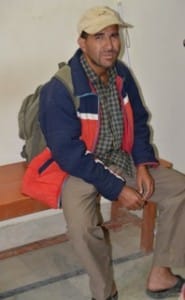How a Great Man Gives Back
Being around Dr. Bidya is a remarkable experience. He exemplifies so much that is noble about being gifted and humble. As he has said many times, the most important quality is to want to help. His life, starting as an instrument cleaner in an operation room to becoming a sought-after cataract teacher throughout the world, is a story of being helped and nudged forward. Here is an example of him passing on the assistance.

The patient was likely in his early thirties and was quietly sitting on the bench. Dr. Bidya had him come over and we looked at the sorry sight in both of his eyes. At age ten he develop the dreaded Stevens Johnson Syndrome. Even in America it is a blinding condition in which the mucous membranes of the eye develop blisters and then create intractable scarring and blindness, along with horrible symptoms of dry eyes.
His left eye was “leatherized”. The once mucous membranes of the eye had been replaced with dry tissue that looked like cracked leather. He had no vision and no moisture.
The right eye had extensive blood vessels on the cornea but there was some area above that allowed him to navigate around a room. It was also bone dry.
Suddenly Dr. Bidya became real quiet and I saw a totally new but not unexpected side. He went into counseling mode. I left the room and took a second picture from a doorway from a second room away. After a long time, he came out to tell me what he was discussing with the patient. The young man could see to take care of himself but due to his blindness he could not work. His parents were dead and he was living with his sister and her husband. There was considerable tension in the living situation and no obvious help to extradite himself from living with others.
In Nepal legally blind patients do not get any direct financial benefits such as money for food or rent. Dr. Bidya was proposing that the man move into the hospital complex and work for the hospital. Dr. Bidya knew of a training program in Kathmandu that would help him train to answer the telephones. If that worked out, he would be able to save some money and would have an exit strategy to get out of his difficult living situation in his brother-in-law’s house.
Just after leaving this touching situation, a very professional looking friendly face came up to me and asked about Miss Kevin. I recognized her as the cook that had worked with us when we first went to Geta Eye Hospital to teach corneal transplants. I asked what she was doing. She was so proud to tell me that she was working in registration of patients and doing the initial visual acuity testing. For her, this was a marvelous upgrade from cooking and cleaning.
Dr. Bidya has continued the model of the Norwegian founders of Geta Eye Hospital who helped propel his career forward. He has more than 40 employees living inside the walls of the hospital complex. He tries to bring up people he admires to gain newer skills, just as he worked up from cleaning floors and instruments to doing 300 cataract surgeries a day. I am looking forward to hearing how the blind fellow with Stevens Johnson’s Syndrome does with his chance to move into the hospital complex and become a valued member of the staff.